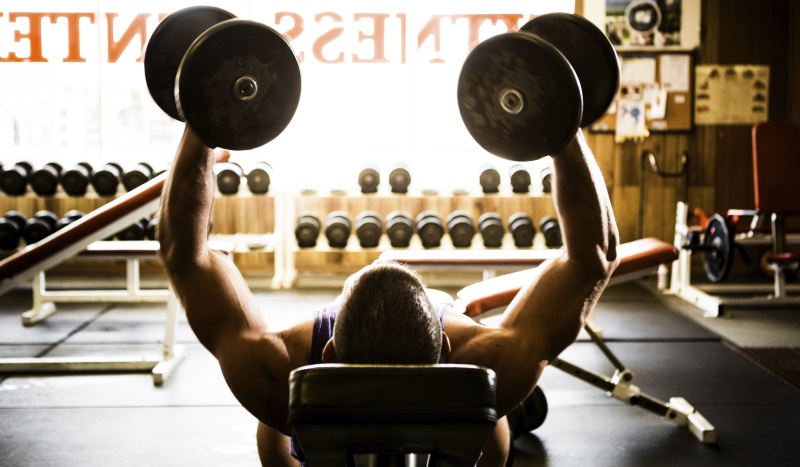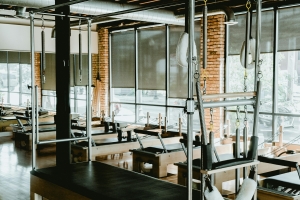The Basics For Strength Training In A Gym

Before you start working on your strength, a good starting point is to define what it is you are trying to achieve, short and long term. This will help to design your programme and ensure you succeed.
But let’s start with an understanding of the natural strength movements our bodies perform on a regular basis, without us even thinking about it.
Natural Strength Moves
There are seven main strength movements that the body performs naturally.
These are the horizontal push and pull, the vertical push and pull, the squat, lifting from the ground and the carry. We do these almost daily, from carrying the shopping to lifting our children. Understanding these helps because if you can focus on improving these natural moves, your body will be more powerful in almost any task.
Fundamental Strength Building Exercises
Building on the seven movements listed above, the basic strength moves in any workout are 6 main exercises. These are the squat, bench press, military press, deadlift, barbell rows and power cleans. It is essential that you start with these and perfect your form, but there are also additional exercises that can help to build strength. These include pull-ups, chin-ups, dips, planks, weighted sit-ups, and side bends.
Getting Quick Results
The first thing to remember is that with any strength programme, you won’t be rapidly transformed overnight. You need to work it and work hard. The key to success is to stick to your programme; missing workouts will not help you achieve your goals. You also need to get the foundations right first and perform all basic moves well.
What you eat is also really important. Eat a good diet that is not based on processed foods but contains a good selection of carbs, vitamins, and minerals. On the subject of diet, the rules are to frequently eat protein, have most of your carbs at breakfast and lots of healthy fats-milk, cheese and nuts. And as we said at the beginning, make a plan based on short-term and long-term goals so that you are not aimlessly working out, but rather you are working towards something. This will help you benchmark success and feel inspired to carry on.
Understanding The Four Big Lifts
The four big lifts are the barbell squat, deadlift, overhead press and bench press. The squat and deadlift are often regarded as the ‘king’ of strength-building moves as they work nearly every muscle in the back of the body, including the glutes, hips, and hamstrings. The overhead press and bench press are pushing exercises that work the shoulders, chest, back and arms.
Performing The Big Four
Getting your form right is essential, particularly when you start upping your weights, as this can affect form and lead to injury. Here we will try to point out a few really common mistakes. Starting with the barbell squat, there are a number of things to bear in mind. A good way to learn the right squatting form is to start with the goblet squat. This is where you take a dumbbell or kettlebell and hold it in front of you, close to your chest. Placing your feet roughly shoulder width apart, keeping your eyes looking straight ahead, squat down until your elbows are inside of your knees. As you squat down, try to put your weight in your heels, which will help keep your back as straight as possible. As you progress to the barbell, these basics will stand you in good stead.
For the deadlift, do remember to get your feet in the right position. Try to have them about halfway under the bar and set at natural width. Sinking your hips is also really important. Sink your hips until your shins touch the barbell, if you start a deadlift with your hips too high you could damage your lower back. Keep your eyes looking ahead and focus on not rounding your back.
The bench press requires you to plant your feet firmly on the floor and really squeeze the bar, pretending you are trying to bend the ends of the bar towards your feet. This helps get your elbows in the best position. In fact, your elbows should be 45 degrees from your body. Keep a tight back and keep your eyes on the ceiling.
For the military press or push press, make sure your feet are shoulder-width apart and that you feel balanced and, most of all, stable. Make sure your forearms are perpendicular to the ground, as you press, lean back slightly, but keep your chest up. Try to also keep your eyes forward when pressing. Lift your eyes up, and your head will follow, which is not good form.
Is A Lifting Belt Necessary?
There is no definitive answer to this. You will see people in the gym using them and others who don’t. You need to make your own call on it, but do understand the main pros and cons so you make an informed call. The main pros are that a belt can help support your spine, it can help you lift heavier weight,s and it can help you feel more confident. The two main arguments against belts are that they can change how you lift, and if worn too tightly, can adversely affect your blood pressure.
Understanding the Role Of the Central Nervous System
The central nervous system (CNS) is hugely important when you are strength training. This is because whilst you are focusing on your muscles, it is actually the CNS that plays a vital role in activating muscle fibres. To ensure that your CNS plays this role, it is vital that you warm up properly before strength training.
What is One Repetition Maximum (1RM)?
1RM is the maximum amount of force you can generate in one maximal contraction. This is often used to determine your maximum strength. You will often see it performed in weight-lifting competitions. But how often should you be testing your 1RM?
The advice is not to focus too much on your 1RM as it is really physically demanding, but instead to focus more on good form, pushing yourself on sets and adding weight where possible. If you really do want to test your 1RM, then only do this every 3-6 months and allow your body to properly recover by taking some training days off afterwards.
Focus on Negative Movement (Eccentric)
What is negative or eccentric movement? Negative movement is essentially the downward movement during lifting of weights, where you lower the weight towards the body. In a simpler explanation, maybe it's the part of the movement that is the 'end part' as we are returning muscles and weights to the starting point of the exercise.
Did you know that muscles can produce the most force during the eccentric phase of your exercise? For example, you can always seem to lower a heavy weight more easily (and control it) than you can lift.
Most of the time, you'll see people complete this part of their exercise more quickly than the engagement (or first) part of the exercise in question.
The negative movement is usually forgotten and not seen as important enough, or is too difficult, thanks to the weight being lifted being too heavy to lift with complete control.
Shortening or Lengthening?
Eccentric or Negative movement is all about the lengthening of the muscle. Contraction is at the start of the exercise as you lift, push or pull the weight. As you then go through to the latter stage of the exercise, when you return to the starting position, with heavy weights, this part of the movement is the bit that will tear the muscle fibres if controlled. As a result, it will make us stronger.
Are There Machines to Help?
The good news is that you also don’t need special equipment. It is out there, called X Force resistance machines, which are 40% heavier on the negative movement, but you can simply use any weight equipment or free weights. The key point here is how you perform this part of the exercise.
The key is to continue resistance as you complete the end part of the movement. Done properly, this will hurt! But slow the movement down until the weight is back to its starting point, and you will soon feel the difference. We also wouldn’t advise that you do this in every weight-lifting session. Start by doing it at least once a week, and build up, you will see the difference very quickly
Common Strength Training Workouts
There are a number of popular workouts that you can adopt. This can be a good idea if you are a novice. Starting with an established programme can give you ideas, and in time you can adapt a programme to what suits you more.
Some that you might like to look at include Starting Strength, which is good for novice lifters. This programme has workout A and workout B alternated on three non-consecutive days per week.
Westside Barbell is a training programme that is an advanced system renowned for developing very strong lifters.
Other programmes worth looking at include Wendlers 531, John Christy’s AB split and Smolov Squat Building.







